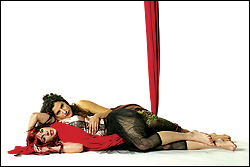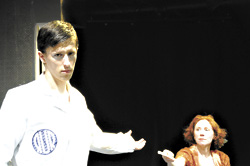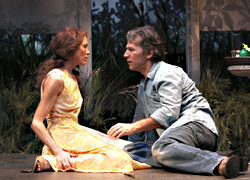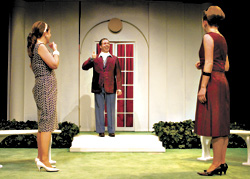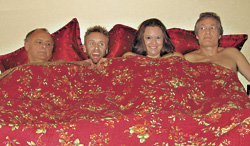Good news first: The hands-down highlight of Rapunzel, A Radical Aerial Re-Telling (through Sunday, April 24, at Velocity MainStage Theatre; 206-463-2128) is the savvy interpretive work of guitarist/singer John Osebold and cellist Josh Neumann. Crackerjack musicians both, they also composed all the original music for the production (Neuman for the cello, with Osebold taking the rest). Osebold, who opens the show with a breathless, Monty Python–esque ballad, doubles as the play’s narrator; his dry humor and deep, proprietary voice are splendidly suited to the task. Neumann, for his part, is an adept percussionist as well as a fantastic cellist. Most impressive, though, is the way these two work together, reading the play’s every rhythm and filling the theater’s vast space with subtle, evocative sounds. Everything they do is tastefully and seamlessly woven into the whole. At one point, during a particularly feverish comic dialogue between the King and Queen, Neumann lays down a simple percussive backing with materials as primitive as chimes and a bowl; it’s an exquisite, less-is-more moment, accent-uating and finally elevating an otherwise unremarkable scene.
Which brings us, unfortunately, to the not-so-good news: not much else about this show fits together very well. Director Elizabeth Klob and choreographers Laura Curry and Esther Edelman would have done well to take a cue from their musicians about the integration of artistic elements. Those elements—the major ones, at least—include playwright Maria Glanz’s reimagining of the Rapunzel story as inspired by Jeannette Winterson’s book Sexing the Cherry, and utilization of the “tissu,” an aerial dance apparatus consisting of rope-length pieces of cloth suspended from the rafters on which the dancers perform stunning acrobatic maneuvers. So far, so good—tissu, Rapunzel’s hair, desire, sexual imprisonment, and spiritual liberation, all flying around the room in a revisionist swarm of bodies.
The problem is that somewhere in there, the narrative got lost. Dance without a strong story is just dance, in the same way 3-D film without a strong plot is just that—a device, an excuse to trot out tricks. The story here never gels. Despite our familiarity with the Rapunzel tale, too much is taken for granted, and the rest is just plain confusing. The symbolism is clunky, inorganic, and the characters are ill-defined and squishy, a fact in no way aided by the staccato, abstract, cutesy dialogue: “Smell?” “Smell.” “Love?” “Love.” It’s like The Electric Company for theatrical hippies. Not to mention the smug use of repetition and a postmodern aesthetic conceit that has the narrator intoning that, well, this is the end, you may as well leave before everything starts up yet again. If you’re going to knock on that wall, you’d better have a good reason.
All of which is really too bad, because the individual elements are in place for something pretty extraordinary. The cast—Edelman and David Godsey (both members of UMO) and Amy Rider— obviously has the right stuff. A couple of the dance routines, in and of themselves, are gorgeous, and there are flashes when the strength of the show’s original conception shines through. But too much of this production is just long hair and hanging around. Instead of being sexy and risky, it only plays at being sexy and risky, and in the end feels more an exercise than anything else, a stew of movement and maneuvers. The show would be vastly improved if: (1) it became purely, wordlessly dance, or (2) the narrative were trimmed and slimmed and straightened out, or (3) Osebold and Neumann jammed for two hours and they let the audience swing around on all those tissues—Rapunzelrobics. Symbolism be damned.
